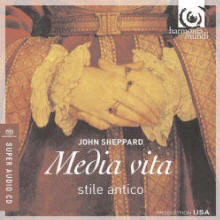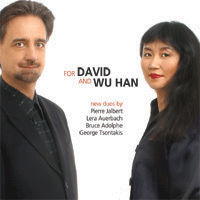|
You are reading the older HTML site
Positive Feedback
ISSUE
Notes
of an Amateur, February, 2010, Part 1
John Sheppard, Media vita, Stile Antico. Harmonia Mundi HMU 807509 This is such an extraordinary recording that on first hearing it was hard to evaluate why. I couldn't say whether it's the choral ensemble, recording engineer Brad Michal, my new interstage transformer driven Audio Note monoblock tube amps, or whether All Hallows Church, Gospel Oak, London is Heaven Itself. What I could say was that this recording makes one of the very most compelling arguments I've heard that audiophiles are not crazy: perfectly recorded sound can make music better as music. I was totally absorbed by it. I've heard the music of John Sheppard before. The Tallis Scholars recorded this very music on vinyl on their own label, Gimell, back in the 1980's, and Harry Christophers' The Sixteen made a couple more LP'sfor Hyperion around the same time that eventually ended up on CD and then as a two CD set. Very nice stuff but NOTHING like this. By the second time through this recording, I began to hear more clearly the constituent virtues involved, and the truth is, it's everything. Stile Antico sing like a single voice of as many as six parts; we are in All Hallows Church, literally within its walls; and there is gorgeous, intoxicatingly complex, Tudor church music swirling all around us. The music itself is more complex than that of the far better known and twenty years younger William Byrd. (More on Byrd next time out.) Sheppard's music is “more difficult to sing than that of his contemporaries, often spanning a vast vocal range, with disjunctive lines and unexpected harmonic progressions...” [Commentator Matthew O'Donovan]. This results in a more emotionally ecstatic and sonically thrilling sound. Sung as perfectly as Stile Antico sing it (as always with this group, sans conductor), captured brilliantly in this extraordinary venue, the result goes a long way toward revealing how much of 'an aid to devotion' this music could/can be. For many, religious and aesthetic experience overlap to such a degree that it is impossible to say where the border, if any, exists. I have not heard anything like this in a long time. Sheppard is a far better composer than I knew and Stile Antico is a far better ensemble. I was impressed by the ensemble's first release, Music for Compline (which actually included some music of Sheppard) and said so back in early 2007 here (https://positive-feedback.com/Issue29/amateur_feb1.htm). Same church, same engineer, different audio gear. I just put Music for Compline on my current system and while it seems more compelling than it did first time around (that's got to be the new amps), it's still not as stunning as their new disc. Something has happened. Time to track down the two CD's they made between these two, Song of Songs and Heavenly Harmonies, both from Harmonia Mundi. I'm taking this CD to the next audio show where it is more than likely to effect new conversions to Christianity and audiophilia both.
Ibérica. Anne Gastinel, cello; Pablo Márquez, guitar. naïve. V5182. What distinguishes classical from popular music is least clear and most interesting in Spanish and North American Latin music. I expect this is because Latin culture itself does not make this distinction as most others do. If rhythm and dance are central to a culture's music, this is likely to be the result. One of the most striking examples of this is the St. Mark Passion by Golijov, where viscerally powerful rhythm is a key component. If your idea of a religious mass is informed by traditional European renaissance and baroque masses, Golijov's takes some getting used to. If you are truly open to the experience, it may tell you something about the neurosis at the heart of the West! For some of us, the border between classical and popular (in this case folk) will be the implicit subject of this appealing album by French cellist Anne Gastinel and Spanish guitarist Pablo Márquez; but not for the musicians. For them, the subject is Spain. Most of this music is transcriptions of works written for other instruments, bringing the cello into terrain it's not usually associated with. This is the kind of thing that often 'discomfits' our expectations or, worse, feels like the plague of crossover. Yo Yo Ma has produced a great many albums of this kind, with mixed results. In ventures like this, taste and judgment are everything. And because we can feel Gastinel emotionally drawn to the Spanish muse rather than trying to 'elevate' or otherwise move it toward the more purely classical tradition, there is no crossover problem at all. The cello and guitar work and play wonderfully together, the cello sometimes simply doubling its partner, sometimes looking to add a sense of melodic line. Each instrument is allotted a solo set, both by Caspar Cassadó. The cello set, Suite for Solo Cello, is stunning, the high point of the entire program for me. This may well be the music that lies behind Pablo Casals' performance of the Bach suites. It reminds us here that we are listening to one of the world's great cellists. Listening to her play the Suite, I have to believe it belongs in the cello repertoire alongside Kodaly's. Coming out of the solo suite and back into music for both performers is like coming out of a brilliant cadenza. If you are a fan of Anne Gastinel, you don't need my recommendation. If not, make your own call, keeping especially in mind what I've said about the Cassadó suite.
For David and Wu Han. Duos by Pierre Jalbert, Lera Auerbach, Bruce Adolphe, George Tsontakis. David Finckel, cello. Wu Han, piano. Artistled 11001-2. The career of the duo of David Finckel & Wu Han has risen steadily over the last decade to the point that musically it now rides comfortably alongside that of Finckel's 'day job' with the Emerson Quartet. Their work as a duo is not as widely known, since these two very fine musicians have chosen to record themselves on their own (superbly engineered) label, available only by direct purchase through the Artistled website (www.artistled.com). But among those of us who stick our musical noses virtually everywhere, nothing they do remains unnoticed or unappreciated. Their recording of the Beethoven Sonatas for Cello and Piano (performed 'live' recently in New York City) remains my favorite among a world of formidable competition. This their latest release, For David and Wu Han, is four works for cello and piano composed expressly for them by contemporary composers who are familiar with their great skill and passionate style as a duo. All four works were composed within the last eleven years. As a program they provide an interesting, sometimes exciting, window into an area of contemporary chamber music that most of us know little about. The 2007 Sonata by Pierre Jalbert, begins with a haunting, gnarled, and passionately searching first movement, which, despite becoming more rhythmically, almost manically, driven in the second, remains under the influence of the opening throughout. Shadows and brooding haunt the third movement which moves quickly back to more urgency in the fourth and final. Overall this a movingly unsettled, elusive work which draws on all of the technical skills of the performers to execute. Lera Auerbach's 2002 Sonata is a bolder, less arch work, full of assertion and drama. To my ears it incarnates a nineteenth century romantic sensibility into modern form and tonality with grand success. Would that more contemporary composers could remember as well as she where we come from. The score enables Wu Han in particular to remind us what a formidably great musician she is. Auerbach was born in Russia, and though she defected to the US at age seventeen, her musical roots are strong. By the time we are into the third and fourth movements of her sonata, twentieth century Russian musical spirits abound, from Shostakovich to Silvestrov and Kanchelli. That said, they are all securely a part of a strong, new (to me), and exciting musical personality. Auerbach remains very well known in Russia, as much for her poetry as her music. This is a hugely difficult work to perform, and it is clear the composer knew for whom she was writing! It's time to seek out more work by this composer. If you want to beat me to her, Auerbach's work is available on Bis, Hannsler, and Capriccio. Bruce Adolph's 1998 Couple offers a warmer, more lyrical and rhapsodic voice, born of a far less restless and passionate imagination. That Finckel and Wu Han can deliver this work as persuasively as they do tells us why composers of different sensibilities compose for them. The excellence of the engineering of this recording while everywhere evident is especially notable on this work. Da-Hong Seetto, the invisible third member of this 'trio,' continues his great work for Artistled. George Tsontakis's 2008 Mirror Image comes across to me as modern dance. The dance becomes more introspective in its third movement, Mirror on the Wall, more expressive in the final movement. This work has much of the feel of the two musicians in it, an opinion I later find the composer shares! The world of contemporary chamber music needs more musicians like Finckel and Wu Han—and more labels like Artistled. I look forward to hearing and reviewing the recordings of their 2009 Music @ Menlo festival due out soon. Note: The program notes to this album are wonderfully informative about the four composers, who in turn comment on their own work recorded here. System used for this audition: Audio Note CDT3 transport and Dac 4.1 Balanced Signature. Audio Note M6 tubed preamplifier and Audio Note tubed (300B) P4 Balanced monoblock amplifier. Audio Note E/SPe HE speakers. Audio Note Pallas and Sootto interconnects; Audio Note Sogon speaker cables. Bob Neill, in addition to being an occasional equipment and regular music reviewer for Positive- Feedback Online, is also proprietor of Amherst Audio in Amherst, Massachusetts, which sells equipment from Audio Note, Blue Circle, and JM Reynaud, among others.
|



